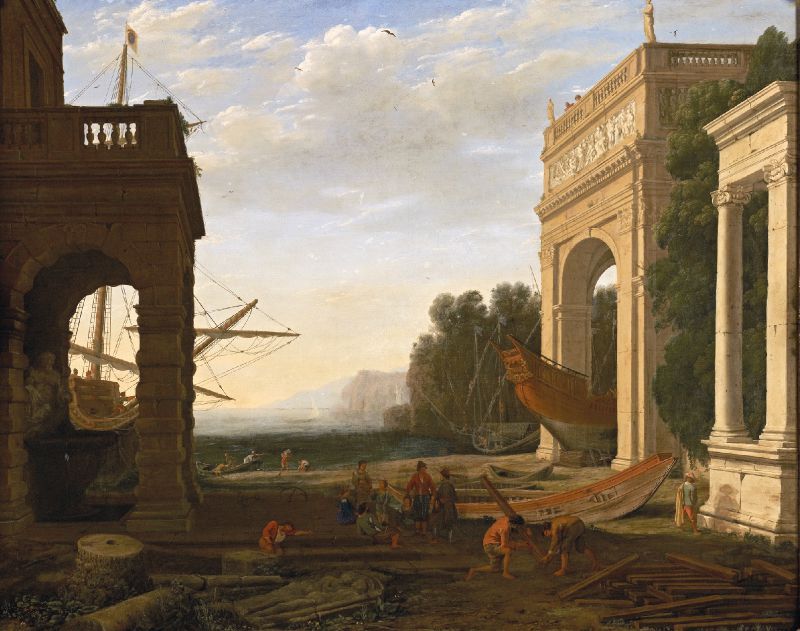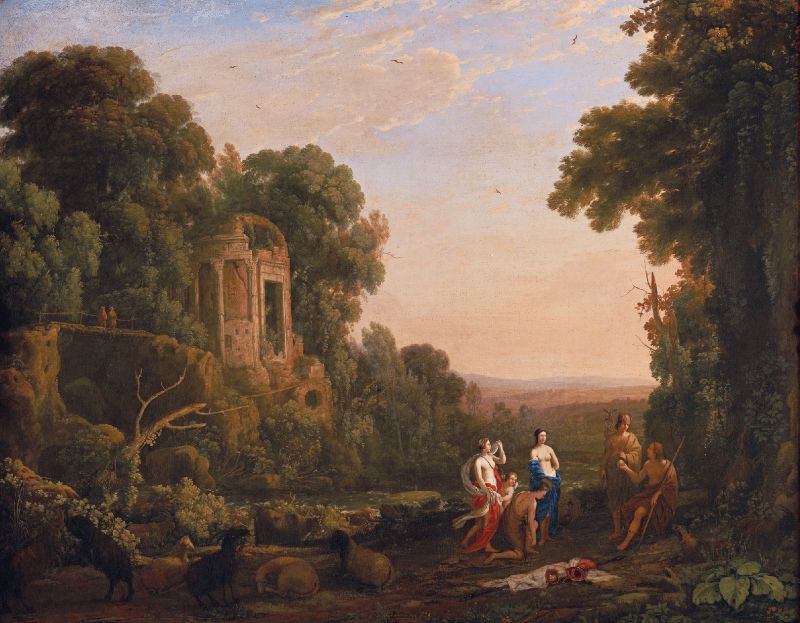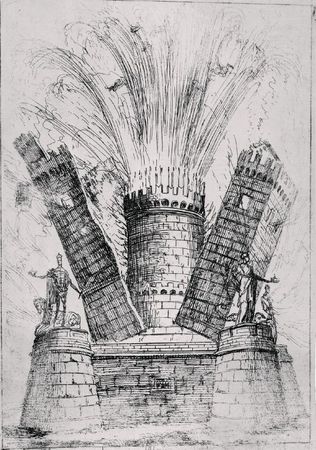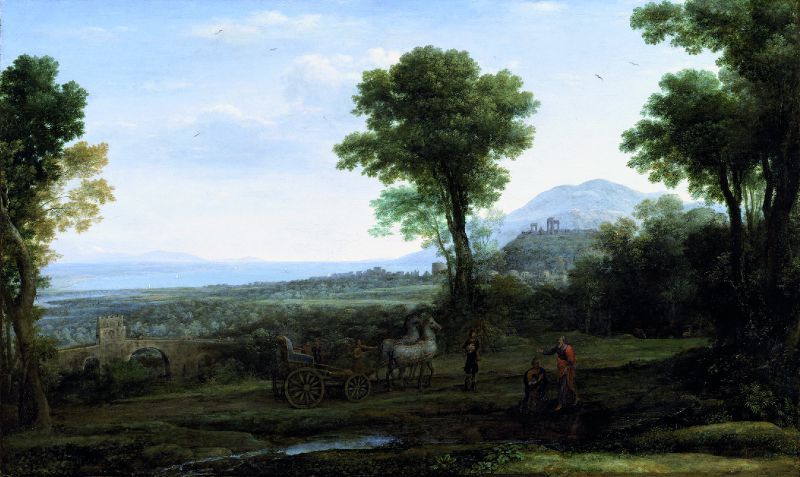Beginning February 3, 2012, the Städel Museum in Frankfurt showcased the work of
Claude Lorrain (c. 1600–1682), in a monographic exhibition, the first in Germany
since 1983.“Claude Lorrain: The Enchanted Landscape” presented about one
hundred and thirty works from all phases of the French Baroque artist’s production.
Loans were made available by the British Museum and the National Gallery in
London, the Petit Palais in Paris, and the Museum of Prints and Drawings in Berlin,
among others. Developed together with the Ashmolean Museum in Oxford, the
presentation highlights Lorrain as a highly reflected artist producing outstanding and
original works in each of the three media.
Claude Gellée, known as Le Lorrain (“The Lotharingian”), Claude Lorrain, or
traditionally just Claude in English, was born in Chamagne, a village near Nancy, in
Lorraine in 1600. Still in his youth, he went to Rome where he remained until the end
of his life excepting a short return to his homeland in 1625. From his beginnings,
Claude primarily devoted himself to landscape painting: his pictures were such a
success that he soon received commissions from the pope, powerful cardinals, and
European princes. From the mid-1630s till the end of his days, the artist, who had no
big workshop and virtually no pupils, had to work hard to satisfy the demand for his
paintings. His oeuvre encompasses approximately 250 paintings, 1,200 drawings,
and 44 prints.
Claude based his paintings on the studies he made during numerous excursions
through the rural environs of Rome, relying on precisely developed compositions to
create timeless classic landscapes. Already during his life-time he was particularly
held in high regard in Italy and France, while his art excited the utmost admiration in
England and Germany in the eighteenth century. Travelers from England who, in
keeping with their station, visited Italy on their Grand Tour acquired many of the
artist’s paintings, and the greater part of his drawings and several of his etchings are
also to be found in English collections today.
Claude’s works not only exercised a formative influence on England’s fine arts of the
eighteenth and nineteenth centuries like on the painter William Turner, but especially
on English ornamental gardening, which mirrors the idealized landscape so typical of
Lorrain – a landscape that strikes us as good as natural thanks to its most precise
layout. Germany’s most famous “Grand Tourist,” Johann Wolfgang von Goethe,
aimed at this peculiar characteristic when he described Claude’s pictures as works
that possess “the highest truth, but no trace of reality” and said that “in Claude
Lorrain, nature declares itself eternal.” Goethe’s high regard for the artist reflects that
Claude profoundly influenced not only English, but also eighteenth-century German
artists, particularly the landscape painters working in Rome, such as Johann Heinrich
Wilhelm Tischbein. As Claude’s works were mainly purchased by well-off English
travelers, though, they are to be found only sporadically in German collections.
Besides five drawings and about forty etchings, the Städel possesses a significant
late painting by the master: “Christ Appears before Mary Magdalene (Noli me
tangere).”
The exhibition on display on the upper floor of the exhibition building offered a
chronological view of Claude’s production. The first hall was reserved for the
presentation of the artist’s early work, which mainly shows Arcadian pastoral scenes
and views of harbors. The large-format early pair of paintings
Image may be NSFW.
Clik here to view.

“Coast View” and
Image may be NSFW.
Clik here to view.

“The Judgment of Paris” from 1633
was rounded off with nature studies from earlysketchbooks and etchings from the 1630s.
Another early painting is a work for Pope Urban VIII:
Image may be NSFW.
Clik here to view.

“Landscape with Rustic Dance.”
This work was accompanied by pertinent drawings conveying a first impression of the relationship between Claude’s painting, drawing, and graphic art.
The tour continued with drawings and prints dating from Claude’s middle phase of
production like the painting
Image may be NSFW.
Clik here to view.

“A Seaport” from 1644
and the large
Image may be NSFW.
Clik here to view.

“Landscape with the Adoration of the Golden Calf” from 1653,
which constituted another focus of the exhibition.
Outstanding works on paper reveal a largely unknown aspect of the artist.
Claude not only made drawings in preparation of his paintings, but also for the sake
of drawing itself, showing a versatility that was entirely unusual for a seventeenthcentury
artist. Nature and composition studies are to be found next to drawings
documenting completed paintings; studies which have actually fulfilled their function
have been touched up and modified just for the artist’s pleasure. From the mid-1630s
on, Claude made drawings after his own paintings in special paper books; initially
aimed at preventing that works by other artists were sold as his, these drawings in
what he called his “Liber Veritatis” (Book of Truth) increasingly turned into a medium
of reflection.
Though Claude was interested in the technique of etching especially in his early
years, he experimented with this medium as he did with drawing and, throughout his
career as an artist, created works that rank among the most important of their kind in
the seventeenth century. The exhibition will present Claude’s etchings, far less
numerous than his drawings, almost in their entirety. The complete spectacular
“Fireworks” series (1637):
Image may be NSFW.
Clik here to view.

Image may be NSFW.
Clik here to view.

Image may be NSFW.
Clik here to view.

Image may be NSFW.
Clik here to view.

which captures festivities in the Piazza di Spagna lasting for several days, was displayed for the first time.
Biblical and mythological motifs prevail in Claude’s later work, their subjects
reverberating in the landscapes in which they are embedded. Claude was an
unequalled master in rendering light and the subtlest atmospheric nuances; however,
the harmonic balance of his compositions, the calm, serene coexistence of man and
nature, is always endowed with an inner dynamics charged with tension which we
grasp step by step. The Frankfurt painting
Image may be NSFW.
Clik here to view.
_-_Google_Art_Project.jpg/800px-Claude_Lorrain_-_Landscape_with_Christ_appearing_to_St._Mary_Magdalene_(%22Noli_me_tangere%22)_-_Google_Art_Project.jpg)
“Christ Appears before Mary Magdalene(Noli me tangere)” and
Image may be NSFW.
Clik here to view.

the Oxford work “Landscape with Ascanius Shooting the Stag of Sylvia” (1682)
illustrated this in a particularly striking way.
Claude’s working method did not comply with what the academies taught at that time.
Based on a thorough knowledge of nature, he composed his works by using
elements that repeat themselves in ever new variations and were taken from his
carefully guarded store of drawings. The approach he pursued was an almost
abstract one of “theme and variations” – a method that entailed an increasing
intensification. A specific feature of his production was working with pendants: in the
1630s, Claude developed an individual artistic concept of pairs of (painted or
engraved) pictures revealing certain compositional parallels or opposites. He often
combined an Arcadian scenery with a view of the sea or a morning and an evening
scene. How this concept of pendants, which Claude expounded in the course of his
career, enhances the extraordinary quality of his compositions through a mutual and
manifold poetic reflection will be demonstrated impressively in the presentation of
numerous examples such as “Coast View” (1633) and “The Judgment of Paris”(1633),
“Christ Appears before Mary Magdalene” (1681) (all 3 above) and
Image may be NSFW.
Clik here to view.

“Landscape with the Baptism of the Eunuch” (1678),
as well as “Landscape with Ascanius” (1682) (above) and
Image may be NSFW.
Clik here to view.

“View of Carthage with Dido and Aeneas” (1675/76).
From an interesting review of an earlier version of the exnibition:
Still less do Claude’s objects have body. Strange geometrical flanges sometimes hug the canvas edge, nominally representing antique architecture: you only read them right when you realise they have no function except to obstruct or recede. His anatomy-free figure painting has always been a standing joke – he knew it, we’re told, but refused to subcontract the task. What you get instead of volume and inner structure is gorgeously variegated optical texture, an unsurpassed attention to the play of light on the fractal surfaces of foliage, rocks and water. Yet the underlying clearheadedness of the operation ensures that the canvas is never cluttered or fussy. Claude is at once greatly generous and greatly detached: all he is really thinking about is behind and before, recession and obstruction.Similar works not in the show:
Image may be NSFW.
Clik here to view.

Claude Lorrain, Landscape with Country Dance, a drawing
Italy, 1640-41
Image may be NSFW.
Clik here to view.

“The Judgment of Paris” from 1646-6
Image may be NSFW.
Clik here to view.

Coast View with Apollo and the Cumaean Sibyl 1647
Image may be NSFW.
Clik here to view.

A Seaport at Sunrise 1674